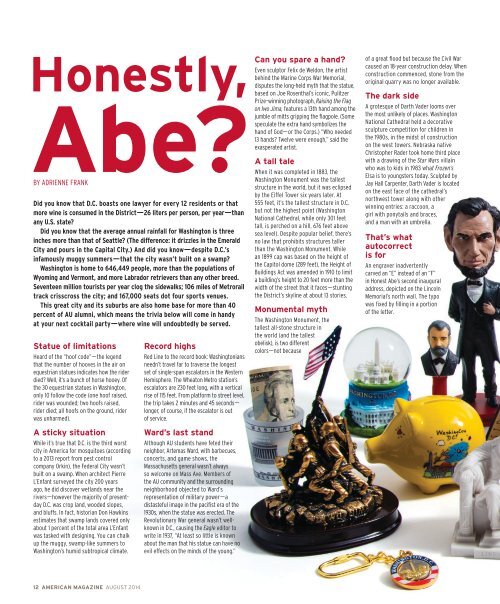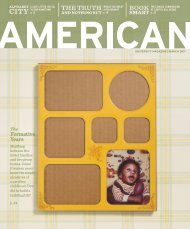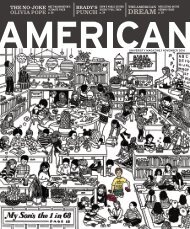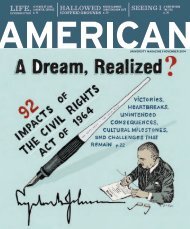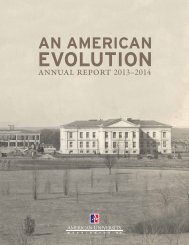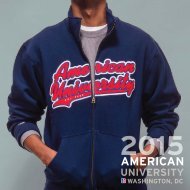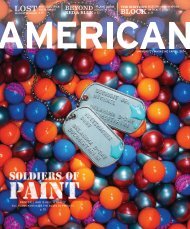American Magazine: August 2014
Create successful ePaper yourself
Turn your PDF publications into a flip-book with our unique Google optimized e-Paper software.
BY ADRIENNE FRANK<br />
Did you know that D.C. boasts one lawyer for every 12 residents or that<br />
more wine is consumed in the District—26 liters per person, per year—than<br />
any U.S. state?<br />
Did you know that the average annual rainfall for Washington is three<br />
inches more than that of Seattle? (The difference: it drizzles in the Emerald<br />
City and pours in the Capital City.) And did you know—despite D.C.’s<br />
infamously muggy summers—that the city wasn’t built on a swamp?<br />
Washington is home to 646,449 people, more than the populations of<br />
Wyoming and Vermont, and more Labrador retrievers than any other breed.<br />
Seventeen million tourists per year clog the sidewalks; 106 miles of Metrorail<br />
track crisscross the city; and 167,000 seats dot four sports venues.<br />
This great city and its suburbs are also home base for more than 40<br />
percent of AU alumni, which means the trivia below will come in handy<br />
at your next cocktail party—where wine will undoubtedly be served.<br />
Statue of limitations<br />
Heard of the “hoof code”—the legend<br />
that the number of hooves in the air on<br />
equestrian statues indicates how the rider<br />
died? Well, it’s a bunch of horse hooey. Of<br />
the 30 equestrian statues in Washington,<br />
only 10 follow the code (one hoof raised,<br />
rider was wounded; two hoofs raised,<br />
rider died; all hoofs on the ground, rider<br />
was unharmed).<br />
A sticky situation<br />
While it’s true that D.C. is the third worst<br />
city in America for mosquitoes (according<br />
to a 2013 report from pest control<br />
company Orkin), the Federal City wasn’t<br />
built on a swamp. When architect Pierre<br />
L’Enfant surveyed the city 200 years<br />
ago, he did discover wetlands near the<br />
rivers—however the majority of presentday<br />
D.C. was crop land, wooded slopes,<br />
and bluffs. In fact, historian Don Hawkins<br />
estimates that swamp lands covered only<br />
about 1 percent of the total area L’Enfant<br />
was tasked with designing. You can chalk<br />
up the muggy, swamp-like summers to<br />
Washington’s humid subtropical climate.<br />
Record highs<br />
Red Line to the record book: Washingtonians<br />
needn’t travel far to traverse the longest<br />
set of single-span escalators in the Western<br />
Hemisphere. The Wheaton Metro station’s<br />
escalators are 230 feet long, with a vertical<br />
rise of 115 feet. From platform to street level,<br />
the trip takes 2 minutes and 45 seconds—<br />
longer, of course, if the escalator is out<br />
of service.<br />
Ward’s last stand<br />
Although AU students have feted their<br />
neighbor, Artemas Ward, with barbecues,<br />
concerts, and game shows, the<br />
Massachusetts general wasn’t always<br />
so welcome on Mass Ave. Members of<br />
the AU community and the surrounding<br />
neighborhood objected to Ward’s<br />
representation of military power—a<br />
distasteful image in the pacifist era of the<br />
1930s, when the statue was erected. The<br />
Revolutionary War general wasn’t wellknown<br />
in D.C., causing the Eagle editor to<br />
write in 1937, “At least so little is known<br />
about the man that his statue can have no<br />
evil effects on the minds of the young.”<br />
Can you spare a hand?<br />
Even sculptor Felix de Weldon, the artist<br />
behind the Marine Corps War Memorial,<br />
disputes the long-held myth that the statue,<br />
based on Joe Rosenthal’s iconic, Pulitzer<br />
Prize–winning photograph, Raising the Flag<br />
on Iwo Jima, features a 13th hand among the<br />
jumble of mitts gripping the flagpole. (Some<br />
speculate the extra hand symbolizes the<br />
hand of God—or the Corps.) “Who needed<br />
13 hands? Twelve were enough,” said the<br />
exasperated artist.<br />
A tall tale<br />
When it was completed in 1883, the<br />
Washington Monument was the tallest<br />
structure in the world, but it was eclipsed<br />
by the Eiffel Tower six years later. At<br />
555 feet, it’s the tallest structure in D.C.<br />
but not the highest point (Washington<br />
National Cathedral, while only 301 feet<br />
tall, is perched on a hill, 676 feet above<br />
sea level). Despite popular belief, there’s<br />
no law that prohibits structures taller<br />
than the Washington Monument. While<br />
an 1899 cap was based on the height of<br />
the Capitol dome (289 feet), the Height of<br />
Buildings Act was amended in 1910 to limit<br />
a building’s height to 20 feet more than the<br />
width of the street that it faces—stunting<br />
the District’s skyline at about 13 stories.<br />
Monumental myth<br />
The Washington Monument, the<br />
tallest all-stone structure in<br />
the world (and the tallest<br />
obelisk), is two different<br />
colors—not because<br />
of a great flood but because the Civil War<br />
caused an 18-year construction delay. When<br />
construction commenced, stone from the<br />
original quarry was no longer available.<br />
The dark side<br />
A grotesque of Darth Vader looms over<br />
the most unlikely of places. Washington<br />
National Cathedral held a decorative<br />
sculpture competition for children in<br />
the 1980s, in the midst of construction<br />
on the west towers. Nebraska native<br />
Christopher Rader took home third place<br />
with a drawing of the Star Wars villain<br />
who was to kids in 1983 what Frozen’s<br />
Elsa is to youngsters today. Sculpted by<br />
Jay Hall Carpenter, Darth Vader is located<br />
on the east face of the cathedral’s<br />
northwest tower along with other<br />
winning entries: a raccoon, a<br />
girl with ponytails and braces,<br />
and a man with an umbrella.<br />
That’s what<br />
autocorrect<br />
is for<br />
An engraver inadvertently<br />
carved an “E” instead of an “F”<br />
in Honest Abe’s second inaugural<br />
address, depicted on the Lincoln<br />
Memorial’s north wall. The typo<br />
was fixed by filling in a portion<br />
of the letter.<br />
12 AMERICAN MAGAZINE AUGUST <strong>2014</strong>


